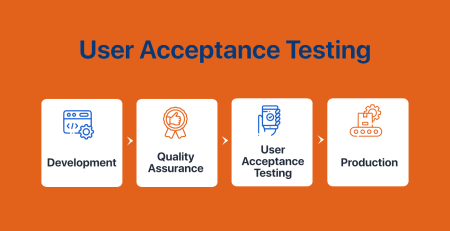10 Benefits of Automation Testing in Software Development
In the contemporary realm of software development and testing, the demand for swiftness, effectiveness, and dependability takes center stage. Software systems are growing in intricacy, intensifying the urgency for developers to swiftly deliver top-notch software. This is precisely where the practice of automation testing comes into play as a saving grace. Automation testing brings forth an array of advantages that hold the potential to greatly elevate the software development journey. Within this blog post, we shall delve into the paramount significance of automation testing by uncovering the ten most compelling benefits it offers to the realm of software development.
1.Reusability
Reusability, a cornerstone concept in the realm of software development and testing, is rooted in the notion of crafting code, components, or resources that possess the adaptability to be applied across various facets of a software project or extend their utility to entirely different projects. This practice, replete with an array of advantages, firmly establishes itself as a fundamental principle within the domain of modern software engineering. To initiate, reusability serves as a potent driver for augmenting the efficiency inherent in the development process. Instead of embarking on the laborious task of recreating the same functionality from scratch each time a similar need arises, developers have the option to harness the capabilities of pre-existing, meticulously tested components. This approach, in turn, ushers in swifter development cycles and an accelerated time-to-market for software products.
Furthermore, reusability champions the cause of resource optimization. It minimizes redundancy by enabling the recycling of proven components, ultimately conserving both time and effort. The outcome is a more streamlined and expedited development process that facilitates the swift release of products. This approach not only enhances efficiency but also reinforces the reliability of software applications. It allows developers to rely on well-established and thoroughly tested components, diminishing the likelihood of introducing new bugs or issues into the codebase.
In summation, reusability emerges as an indispensable strategy that significantly augments productivity, fosters cost-effective development, and accelerates time-to-market. By harnessing the potential of existing components and resources, developers navigate the intricacies of software development with heightened efficiency and effectiveness.
2.Consistency
Consistency is a fundamental principle in software development that plays a pivotal role in ensuring the reliability, maintainability, and overall quality of software systems. It encompasses various aspects of the development process, including coding standards, design patterns, user interfaces, and documentation. Consistency is essential because it simplifies understanding, collaboration, and maintenance within development teams. When code follows consistent naming conventions, formatting guidelines, and coding styles, it becomes more readable and accessible to all team members. This fosters effective communication and knowledge sharing, reducing the learning curve for new team members and enabling quicker onboarding.
Furthermore, consistency significantly contributes to error reduction and bug prevention. Inconsistent code and design choices often lead to confusion, misunderstandings, and unintended consequences. When developers adhere to consistent patterns and practices, they are less likely to introduce errors during development. This results in a more stable and predictable software system, saving valuable time and resources that might otherwise be spent on debugging and troubleshooting.
Additionally, consistency applies to the user experience, where it is essential for assuring customer pleasure. Consistency in user interfaces and user experiences (UI/UX) refers to how elements behave and look throughout an application. By making the program more user-friendly and intuitive, this consistency improves usability, which eventually results in improved user adoption and customer satisfaction rates. Additionally, it lessens the need for users to learn new interactions for various software components, increasing overall efficiency and user assurance. In conclusion, consistency is essential for effective software development as it fosters clarity, dependability, and user happiness. It is not only a desired quality, though. Development teams may expedite their procedures, lower costs, and increase productivity by following uniform coding standards, design concepts, and user interface requirements.
3.Speed
Modern software development places a high value on speed, which affects several phases of the software development lifecycle. Time-to-market is, first and foremost, directly impacted by software development speed. Businesses must release software products and upgrades quickly to be competitive in today’s fast-paced technological environment. Organizations may react fast to shifting market conditions and client needs with the help of rapid development techniques. Businesses may gain a competitive advantage, seize new possibilities, and stay one step ahead of the competition by reducing time-to-market.
Additionally, speed enhances the agility and flexibility of development teams. Agile and DevOps methodologies prioritize rapid development cycles and continuous integration and delivery (CI/CD). These practices rely on automated testing, deployment pipelines, and collaboration tools to accelerate development. Speed enables teams to iterate quickly, gather feedback from users, and make necessary adjustments promptly. This iterative approach allows developers to address issues and improve software continuously, resulting in higher-quality products and increased customer satisfaction.
Moreover, speed in software development is closely tied to innovation. Fast-paced development environments encourage creativity and experimentation. Developers have the freedom to explore new ideas and technologies, driving innovation within the organization. Speedy development processes also facilitate the adoption of emerging technologies, such as artificial intelligence, machine learning, and cloud computing, enabling organizations to stay at the forefront of technological advancements and deliver cutting-edge solutions to their customers. In conclusion, speed is a critical factor in software development, enabling organizations to meet market demands, respond to changes, and foster innovation. Embracing fast-paced development practices and tools is essential for staying competitive in today’s dynamic technology landscape.
4.Coverage
Coverage, in the context of software testing, refers to the extent to which a software application’s functionality, code, and various scenarios are tested. It is a critical metric that assesses the thoroughness of testing efforts and is essential for ensuring the reliability and quality of the software. Comprehensive test coverage offers several advantages in software development.
Firstly, test coverage helps identify gaps in testing. By tracking what parts of the codebase or functionality have been tested and what hasn’t, development teams can ensure that all critical aspects of the software are thoroughly examined. This reduces the risk of leaving vulnerabilities or undiscovered bugs in untested areas, improving the overall quality of the software.
Secondly, test coverage is essential for risk assessment. It allows teams to prioritize testing efforts based on the criticality of different code segments or features. For example, code related to financial transactions or security measures may require higher coverage than less critical areas. This risk-based approach to testing helps allocate resources effectively and ensure that the most important parts of the software receive adequate attention.
Finally, comprehensive test coverage contributes to higher software reliability. When a broad range of scenarios and edge cases are tested, it increases the likelihood of detecting and fixing potential issues before they impact end-users. This, in turn, leads to improved user satisfaction and reduced post-release support and maintenance efforts.
In conclusion, test coverage is a vital aspect of software testing that directly impacts the quality and reliability of software products. By systematically assessing and improving coverage, development teams can mitigate risks, identify vulnerabilities, and deliver software that meets or exceeds user expectations. Comprehensive test coverage is a cornerstone of effective quality assurance practices in software development.
5.Regression Testing
Regression testing is a critical phase in the software testing process, focused on ensuring that new code changes or updates to a software application do not introduce new defects or disrupt existing functionality. It is an essential practice in software development to maintain the integrity of the software over time.
Firstly, regression testing helps safeguard against unintended consequences of code modifications. As software evolves through iterative development cycles, it’s common for developers to make changes in one part of the codebase that inadvertently affect other, seemingly unrelated parts. Regression tests serve as a safety net, automatically verifying that previously tested and working features remain functional after code changes. By identifying regressions early in the development cycle, teams can address issues promptly, reducing the cost and complexity of fixing defects later in the process.
Regression testing also improves the dependability and quality of software. It makes ensuring that the application’s fundamental functionality is stable even if new features are included or current ones are improved. This is particularly important since software failures can have serious repercussions in sectors like banking, healthcare, and aerospace. Regression testing give stakeholders assurance that the software performs as planned and complies with regulations.
Finally, regression testing supports continuous integration and continuous delivery (CI/CD) pipelines. By automating the execution of regression test suites in CI/CD pipelines, development teams can achieve rapid feedback on code changes. This accelerates the software development process, enabling faster releases while maintaining a high level of software quality.
In conclusion, regression testing is a vital practice that ensures the ongoing reliability and quality of software applications in a dynamic development environment. It mitigates the risk of introducing defects during the development process, enhances software stability, and supports the adoption of agile development methodologies like CI/CD, ultimately leading to more efficient and reliable software delivery.
6.Parallel Testing
Parallel testing is a testing approach that involves executing multiple test cases or test suites simultaneously on different environments, devices, or configurations. This method significantly accelerates the testing process, reduces the overall testing time, and enhances test coverage.
First of all, parallel testing can significantly shorten the testing period. Traditional sequential testing involves running each test case one at a time, which takes a long time, especially when working with a lot of test cases or different platforms. On the other side, parallel testing enables numerous test cases to run simultaneously, optimizing resource usage and noticeably speeding up test performance. Fast feedback on code changes is essential in today’s fast-paced software development environment, therefore this is extremely significant.
Parallel testing also increases test coverage. It allows testing to be done simultaneously across many environments or configurations, which is very useful in cross-browser and cross-device testing scenarios. Developers may guarantee that their product is compatible with a variety of platforms by performing tests concurrently on several browsers, operating systems, or devices. This lowers the possibility of post-release errors and enhances the user experience.
Finally, parallel testing enhances efficiency and scalability in software development. Automated testing frameworks and cloud-based testing services make it easier than ever to implement parallel testing. This approach allows development teams to scale their testing efforts as needed, accommodating the growing complexity of modern software applications and the demand for faster release cycles.
In conclusion, parallel testing is a valuable strategy in software development for achieving faster, more efficient, and more comprehensive testing. By harnessing the power of parallelism, development teams can deliver high-quality software more quickly while ensuring compatibility across various platforms and configurations, ultimately leading to increased customer satisfaction and a competitive edge in the market.
7.Continuous Integration (CI) and Continuous Deployment (CD)
Continuous Integration (CI) and Continuous Deployment (CD) are two essential practices in modern software development that focus on automating and streamlining the process of building, testing, and deploying software. These practices play a pivotal role in achieving faster development cycles, improving software quality, and enhancing overall development efficiency.
First of all, CI entails the daily automated integration of code changes into a common repository. A battery of tests, including unit tests and integration tests, are triggered by each integration to ensure that the code is accurate. This continuing integration procedure lowers the likelihood of introducing bugs into the codebase by assisting in the early identification of issues. CI promotes teamwork among members of the development team and guarantees that everyone is using the most recent codebase, leading to easier code integration and fewer disputes.
Secondly, CD is the natural extension of CI, where code changes that pass the automated tests in the CI phase are automatically deployed to production or staging environments. CD aims to minimize manual intervention in the deployment process, reducing the potential for human error and ensuring that tested and approved code reaches end-users faster. This practice enables organizations to release software updates and features more frequently, respond rapidly to user feedback, and stay competitive in rapidly evolving markets.
Last but not least, CI/CD approaches encourage an automated, open, and continuous improvement culture inside development teams. They promote the use of tools and methods that automate monotonous jobs like testing, development, and deployment so that developers may concentrate on higher-value and more creative work. Teams may continuously discover bottlenecks and opportunities for improvement in their development processes thanks to continuous monitoring and feedback loops. Organizations that use CI/CD may increase their agility, decrease their time to market, and enhance the quality of their software, all of which boost customer satisfaction and provide them a competitive advantage.
8.Early Bug Detection
Early bug detection is a critical aspect of software development that focuses on identifying and addressing defects, errors, and issues in the software as soon as possible in the development lifecycle. Detecting and resolving bugs early in the process offers numerous benefits that contribute to the overall success of a software project.
Firstly, early bug detection reduces the cost of fixing defects. As a bug or issue persists throughout the development process, it often becomes more complex and costly to address. When issues are identified and addressed at the earliest stages, they are typically simpler to fix, requiring fewer resources and less time. This results in significant cost savings for the organization, as post-release bug fixes can be expensive and may damage a company’s reputation.
Secondly, early bug detection enhances software quality and stability. By identifying and resolving issues before they propagate through the development pipeline, teams can ensure that the software remains reliable and functional throughout the development process. This is particularly crucial for maintaining a positive user experience and preventing the accumulation of critical defects that could delay project timelines or lead to unhappy customers.
Lastly, early bug detection fosters a culture of quality and accountability within development teams. It encourages proactive testing, code reviews, and collaboration among team members to identify and address issues promptly. This culture of vigilance and attention to detail helps prevent defects from slipping through the cracks, resulting in higher software quality and more satisfied end-users.
In conclusion, early bug detection is a fundamental practice that saves time and resources, improves software quality, and promotes a culture of quality assurance within development teams. It is a proactive approach that contributes to the successful and efficient delivery of software projects, ultimately benefiting both the organization and its users.
9.Cost-Effective
Cost-effectiveness is a crucial consideration in software development, as it directly impacts an organization’s budget, profitability, and resource allocation. Achieving cost-effectiveness in software development involves optimizing processes, maximizing resource utilization, and delivering high-quality software solutions within budget constraints.
First off, excellent project management and cost effectiveness go hand in hand. Development teams are given the resources, tools, and time they need to finish projects on schedule and under budget when projects are planned and resourced effectively. Organizations may see possible cost overruns early and take steps to remain below budget by creating clear project objectives, identifying priorities, and periodically reviewing progress.
Secondly, adopting agile methodologies and best practices can lead to cost-effective software development. Agile promotes iterative development, continuous feedback, and collaboration among cross-functional teams. These practices reduce the likelihood of costly rework, scope creep, and project delays. Agile also encourages customer involvement, helping teams prioritize features that provide the most value and avoid unnecessary development efforts that can inflate costs.
Last but not least, automation and tools are essential to cost effectiveness. Testing, deployment, and code review are a few examples of repetitive procedures that may be automated to save time and effort. This not only quickens development cycles but also reduces human error, which eventually lowers the cost of resolving flaws and taking care of problems after a release. Additionally, adopting productivity tools and frameworks may optimize resource allocation, enhance collaboration, and expedite development processes, all of which contribute to total cost savings.
In conclusion, achieving cost-effectiveness in software development requires a multifaceted approach that encompasses efficient project management, agile methodologies, and the adoption of automation and tools. Organizations that prioritize cost-effectiveness can deliver high-quality software solutions while staying within budget constraints, enhancing their competitive edge in the market and ensuring long-term financial sustainability.
10.Increased Test Productivity
Increased test productivity is a key goal in software testing and quality assurance, as it allows testing teams to achieve more with fewer resources while maintaining or even improving the quality of the software. This boost in productivity can be achieved through various strategies and practices that streamline testing processes and make the most of available resources.
Firstly, test automation is a fundamental approach to increasing test productivity. Automated test scripts can execute repetitive and time-consuming test cases much faster than manual testing, reducing the testing cycle. Moreover, automated tests can run concurrently on different configurations and environments, further accelerating the testing process. This increased test coverage and efficiency lead to shorter release cycles and quicker feedback to development teams, enabling them to address issues promptly.
Secondly, improved test management and organization contribute to increased productivity. Utilizing test management tools and well-defined processes helps testing teams efficiently plan, prioritize, and execute test cases. By creating comprehensive test plans, tracking progress, and managing test data effectively, testing teams can maximize their productivity and ensure that testing efforts are aligned with project goals and requirements.
Lastly, enhancing collaboration between development and testing teams can significantly boost test productivity. Closer collaboration fosters clear communication, quicker issue resolution, and a shared understanding of project objectives. Agile methodologies, such as Scrum, promote collaboration through practices like daily stand-up meetings, which allow both teams to discuss progress, identify challenges, and make necessary adjustments, ultimately leading to more productive and efficient testing processes.
In summary, increased test productivity is essential for achieving faster software development cycles, maintaining software quality, and meeting project deadlines. Test automation, efficient test management, and improved collaboration are key strategies that empower testing teams to achieve higher productivity, delivering better software with fewer resources and in less time.
Conclusion
In conclusion, software development is a multifaceted endeavor that requires a careful balance of various principles and practices to achieve success. Whether it’s through reusability, consistency, or speed, software development teams must continually strive for efficiency and effectiveness. Reusability allows developers to build upon past work, reducing duplication of effort and saving time. Consistency ensures that code remains readable and maintainable, reducing errors and fostering collaboration among team members. Speed is essential in today’s competitive landscape, enabling rapid responses to market demands and promoting innovation within development teams.
Test coverage, regression testing, and parallel testing are vital components of quality assurance, helping to identify and address issues early, minimize the risk of defects, and accelerate the testing process. Continuous Integration (CI) and Continuous Deployment (CD) automate and streamline development pipelines, improving efficiency, collaboration, and the rapid delivery of software. Early bug detection and increased test productivity contribute to software quality and cost-effectiveness by reducing the time and resources required to identify and resolve issues.
Cost-effectiveness is a critical consideration, as it impacts an organization’s financial health and competitive advantage. By adopting efficient project management practices, embracing agile methodologies, and leveraging automation, organizations can optimize their resource allocation and deliver high-quality software within budget constraints. In the ever-evolving world of software development, these principles and practices remain essential guides for navigating challenges, delivering exceptional software solutions, and staying at the forefront of innovation in the industry.













Leave a Reply